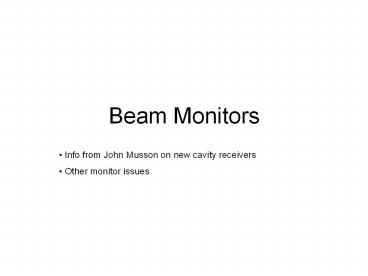Beam%20Monitors PowerPoint PPT Presentation
Title: Beam%20Monitors
1
Beam Monitors
- Info from John Musson on new cavity receivers
- Other monitor issues
2
Cavity BPM performance
- Simulation
- Cavityreceiver output 4160 ?m?A
- (at 75 kHz bandpass, sampling output rate 150
kHz) - At low currents (50 nA)
- 83mm at 150kHz. If we averaged over 0.5
seconds, wed have a processor gain of 270, and
resolution of 0.3 mm. - This averaging can be done with firmware
change to board Alternative We could modify our
counting DAQ readout to average over some time
window - 20 dB LNA boosts signal 10x so 8mm at 150 kHz.
Simple (connectorized) addition. - CONCLUSION Musson is very confident this can be
done
As rated by electronics group
3
Cavity BPM performance
- Simulation
- Cavityreceiver output 4160 ?m?A
- (at 75 kHz bandpass, sampling output rate 150
kHz) - At high currents (50 ?A)
- 83 ?m at 150kHz. When we average over 30 ms,
wed have a processor gain of 70, and resolution
of 1.2 ?m. - Non-ideal system may have less processor gain,
but this can be tested in bench test to get a
first-principles estimate of beam monitor
resolution.
Receiver boards, V1.2 (as used by G0) are
available and ready for installation. We should
communicate on final details (like offset levels)
and push development of low-current mode to be
completed before end of summer.
4
Existing Cavity BCM
- Two cavities, each read out by two parallel,
analog down-convertors - 1 MHz - Most stable and reliable system (but
old)! - 10 kHz - chosen to match bandpass to other
readout electronics, very sensitive to small
drifts of reference oscillator
New cavity BCMs use different electronics,
readout in a different crate. Provides good
opportunity to test for common-mode current
monitor noise.
As rated by electronics group
5
What kind of beam noise might there be?
Frequency spectrum from FFT can be viewed for new
cavities (75 kHz) or the beam loss accounting
current monitors (100kHz) Similar is available
from stripline BPMs, but limited to lower
frequencies (few kHz?)
6
Other beam monitor issues
- Second dispersive BPM
- presently no redundancy in energy monitor
- Spot size upper bound?
- Can we find a way to dither spot size (at
source) to measure sensitivity? - Where will our upper bound on spot size come
from?
PowerShow.com is a leading presentation sharing website. It has millions of presentations already uploaded and available with 1,000s more being uploaded by its users every day. Whatever your area of interest, here you’ll be able to find and view presentations you’ll love and possibly download. And, best of all, it is completely free and easy to use.
You might even have a presentation you’d like to share with others. If so, just upload it to PowerShow.com. We’ll convert it to an HTML5 slideshow that includes all the media types you’ve already added: audio, video, music, pictures, animations and transition effects. Then you can share it with your target audience as well as PowerShow.com’s millions of monthly visitors. And, again, it’s all free.
About the Developers
PowerShow.com is brought to you by CrystalGraphics, the award-winning developer and market-leading publisher of rich-media enhancement products for presentations. Our product offerings include millions of PowerPoint templates, diagrams, animated 3D characters and more.

